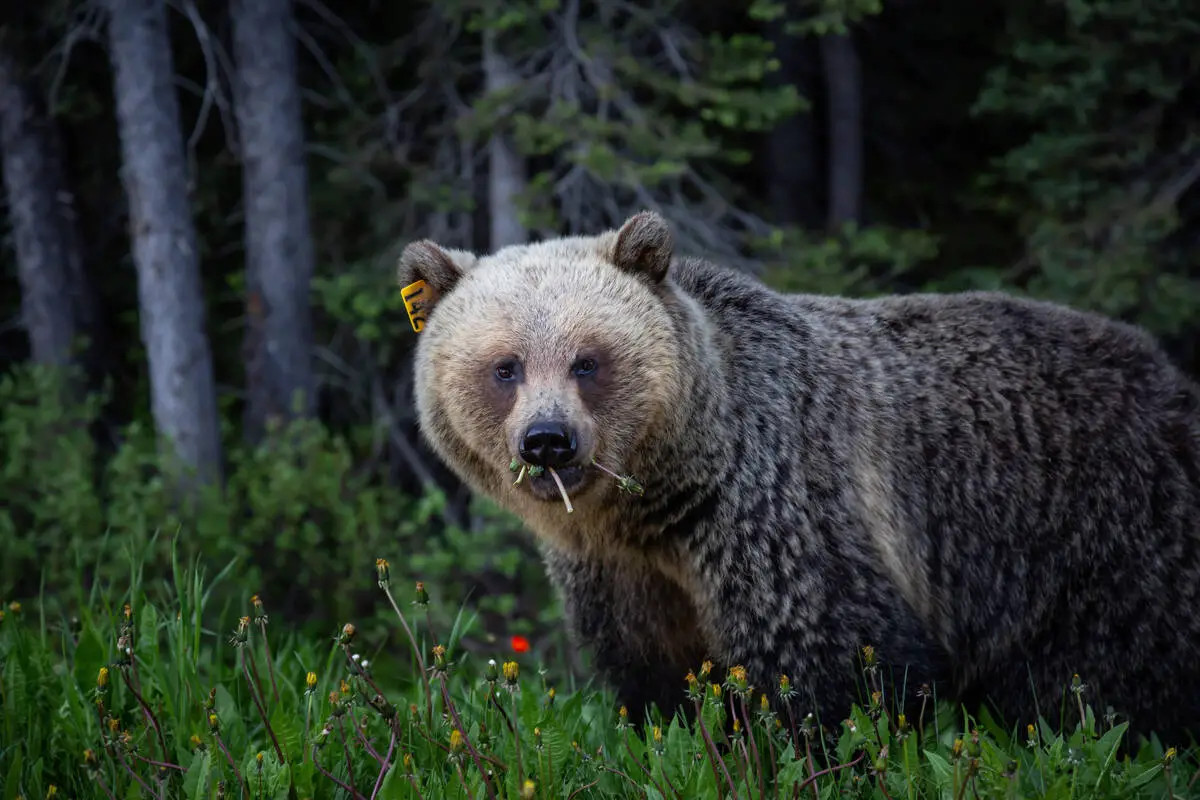One of the most sought-after experiences in Banff National Park is spotting black bears and grizzly bears. In this post, I’ll inform you about the best places for bear sightings in Banff in 2023 and offer tips for safe and successful bear-watching. Pack your binoculars and get ready for an unforgettable experience!
I’ll be the first to admit that the chances of seeing a bear in Banff National Park are not great. I only saw a bear twice in the 1.5 years I lived in Banff.
The first encounter was when a black bear crossed the paved road while walking toward Sundance Canyon. It happened about 150 meters in front of me.
The bear turned its head when it heard me, stopped for a second, and continued. Scary, yes. Intimidating too. But most of all, it was exciting.
Another encounter was on the Icefields Parkway, just after a corner past Peyto Lake. The many parked cars along the road suggested a “bear jam“. A few meters further, a black bear was feeding in a small meadow.
For the rest, I never saw a bear when I lived in the park. But I have heard stories of tourists spotting three or four in just two weeks.
Anyway, I guess you just have to be lucky. If you are, the information below might come in handy.
It’s not a Banff bear report, but you’ll learn where you’ll have the best chances to see one.
Nuff said, let’s dive in!
Where to Spot Bears in Banff National Park?
Where to see bears in Banff? And: What is the best place to see bears in Banff? These are two of the most common questions asked by visitors to the park. Unfortunately, they’re not easy to answer. Sightings can occur anywhere. The good news is that some areas are more likely to have bear activity.
You’re most likely to see a bear in Banff in the following areas:
- Along the Bow Valley Parkway (Highway 1A) between Banff and Lake Louise
- Along the Icefields Parkway (Highway 93) between Lake Louise and Jasper National Park
- On Whitehorn Mountain near Lake Louise. Taking the sightseeing gondola is an excellent idea to spot a bear safely
- Aylmer Pass trail near Lake Minnewanka
While these locations are known for frequent bear sightings, you could also encounter bears in other locations. Even in the town of Banff (although this is not likely).
Still, the chance of seeing a bear is slim. A study published in Movement Ecology in 2022 analyzed two decades’ worth of global positioning data of 34 grizzlies. The bears had GPS collars put on them.
They concluded that when there are many humans around, grizzly bears (and wolves) avoid towns and other developed areas.
Bear encounters typically occur near campgrounds, roadsides and picnic areas. These are all locations where they seek out accessible food sources such as unattended coolers, garbage cans and food scraps.
Which is bad because bears can become aggressive and dangerous when they become habituated to human food and human presence.
Spotting a Bear From Your Car
If you spot a bear from your car, don’t get out. Doing so in your pursuit of wildlife in Banff is illegal. Just pull over at a safe distance, park the car, turn off the engine, and take in the scene.
I know most people don’t do this. Hence, when I came across that bear jam I mentioned above, I saw lots of people standing at the side of the road watching the black bear near the road. It obviously made for a dangerous situation.
Also good to know: If the traffic conditions on the road allow, try to drive a little slower. You could easily miss a fantastic bear-spotting opportunity if you drive fast.
Spotting a Bear While Hiking
In case you spot a bear while hiking, keep a safe distance between you and the animal. Back out and never approach it. Encountering a bear is always a potentially dangerous situation.
To keep yourself protected, you should have bear spray on you, ready to use. If you want to know more about bear spray and where to get it, read the article 19 Things You Need To Know About Bear Spray.
Which Types of Bears Are There in Banff?
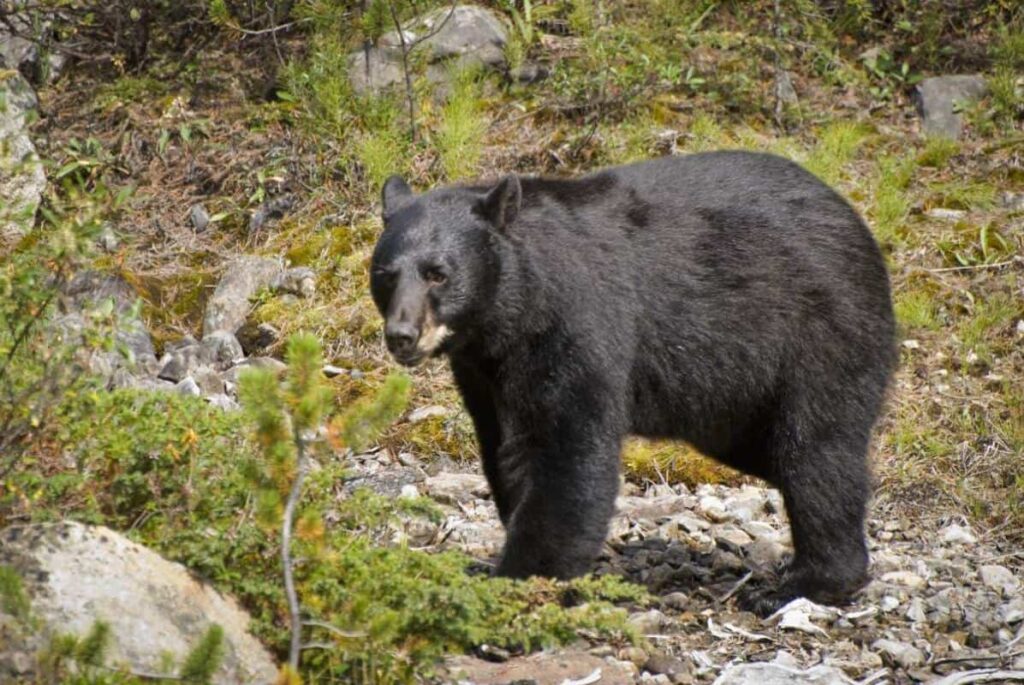
Banff National Park is home to two species of bears: the black bear and the grizzly bear.
Black bears are smaller than grizzlies, with a more slender build. Their fur can range from blond to black.
Black bears are omnivores and eat various foods, including berries, insects and small mammals.
Grizzly bears are larger and more heavily built than black bears, with a distinctive hump on their shoulders and a bowl-shaped face. Their coat ranges from light blond to dark brown.
Like black bears, grizzly bears are omnivores and eat various foods, including berries, fish and small mammals.
It’s necessary to follow safety guidelines when encountering a bear, including making noise, carrying bear spray, and avoiding sudden movements.
How Many Bears Are There in Banff National Park?
The number of bears in Banff National Park is probably not as significant as you expected.
The population of black bears is estimated to be between 20 and 40 bears.
The population of grizzly bears is estimated to be around 65.
Despite these relatively small numbers, it’s definitely possible to spot a bear in the park. It’s a matter of timing. See below.
What Is the Best Time of the Day to Spot Bears?
Black bears and grizzly bears are primarily active in the morning, evening, and night. Your best chances are early morning when bears are actively feeding.
However, to stay away from people, bears have switched to nocturnal behavior in many areas with considerable human activity.
It doesn’t mean you have no chance of spotting a bear during the day. They are spotted at any time of the day.
What Time of the Year Are Bears Most Active?
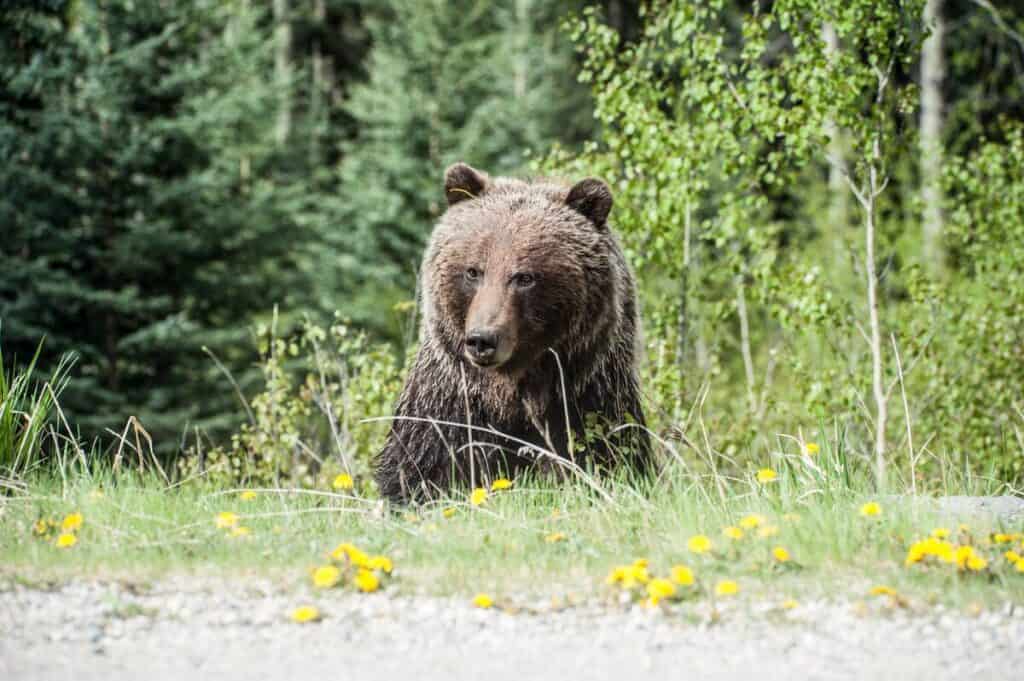
Bears are most active between April and October. They often come out of hibernation in early April. They are most active in September and October, preparing for hibernation. Their “winter sleep” usually begins in November.
Bear Hibernation in Banff
During hibernation, bears chow down as much as they can. They prefer berries in particular. In general, buffaloberries are typically ripe from mid-July to September in Banff, grouse berries are still abundant in October. This implies that you might be close to a bear if you see these berries around this period. So be aware!
Both black bears and grizzlies enjoy eating them. They chow down on as much food as possible to build up their fat reserves for hibernation. This process is called hyperphagia.
Bears in the Canadian Rocky Mountains, including those in Banff National Park, hibernate to conserve energy and survive the harsh winter conditions.
As winter approaches, the bears will find a cozy den, like a cave, a hollow tree, or another sheltered area, and settle in for the winter.
Their hibernation usually lasts from November to April, depending on the weather conditions. During this time, the bears’ metabolic rate slows significantly, and their body temperature drops slightly. They don’t eat, drink, pee, or poo during this time, and their heart rate and breathing also slow down.
Can You See Bears in Winter?
Not all bears hibernate during the winter, which means it’s still possible to encounter bears in winter. So, if you’re planning a visit, keep a safe distance, be aware of your surroundings, and carry bear spray, just in case!
How Dangerous Are Bears?
Bears are among the ten strongest animals on the planet. They are dangerous due to their size, strength and speed. The average grizzly bear, for instance, is as strong as the strength of five human adults combined and has a powerful biting force of around 1000 pounds per square inch (psi).
Additionally, they are about as fast as a horse, so there’s no way you’ll be outrunning a bear.
Because they’re solitary animals, they prefer to live and eat alone, unhindered by the presence of other animals or people. Invading their space may make them aggressive.
There’s one circumstance, in particular, that’s dangerous: when you run into a mother bear with cubs. She is most likely to attack if she senses danger.
The good news: Bears, in general, are NOT aggressive, so attacks are uncommon. While being a massive and muscular animal, a black bear or grizzly bear is typically timid and afraid of people, even though they’re much bigger than humans. Bears are often reserved, quiet creatures with little interest in interacting with people.
How Often Do Bear Attacks Occur in Banff National Park?
A bear attack on humans is extremely rare. While I haven’t been able to find statistics on this topic that go as far back as the park’s establishment in 1885, I did find numbers from 1960 until 2005.
In this time frame, 15 attacks were recorded, resulting in two fatalities, in 1972 and 1980, and 13 injured people.
It appeared that most bear attacks occur in July and August. I guess this makes sense as the park is busiest with tourists in these months.
How to Stay Safe During a Bear Encounter in Banff
If you happen to come across a bear while exploring Banff, it’s super important to know how to stay safe and avoid any potential danger.
- Try to stay chill and avoid making sudden movements or loud noises. This will help prevent the bear from feeling threatened or getting all riled up.
- Try to figure out what kind of bear you’re dealing with. Black bears are usually smaller and more chill than grizzly bears. If it’s a grizzly bear, it’s especially important to be cautious and give the bear plenty of space.
- If the bear doesn’t seem to know you’re there, slowly and quietly move away from the area.
- If the bear has noticed you, try to make yourself look bigger by raising your arms and standing on your tiptoes.
- Speak in a calm, firm voice to let the bear know you’re around. If the bear starts to charge at you, stand your ground and use bear spray if you have it. Aim for the bear’s face and be ready to use multiple bursts if necessary.
It’s also important to know what to look out for to avoid a bear encounter in the first place. Look for fresh tracks, scat, and claw marks on trees. If you see a carcass or hear crows or ravens, a bear might be nearby. Be especially careful in areas with low visibility, like dense brush or around corners on trails.
Dos and Don’ts of Bear Watching in Banff National Park
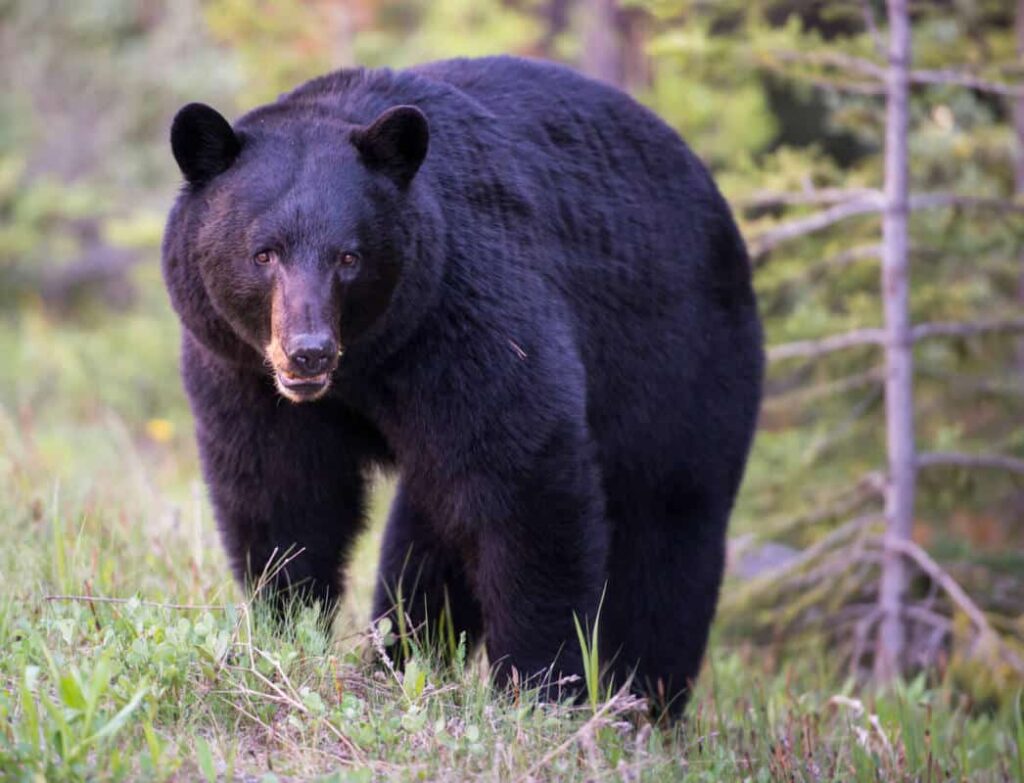
If you’re planning on bear-watching in Banff National Park, there are some essential dos and don’ts to remember to ensure your and the bears’ safety.
Do’s of Bear Watching in Banff
- Keep a safe distance from the bears. Park regulations require visitors to stay at least 100 meters (330 feet) away from bears, both black bears and grizzlies. This way, the bears can do their thing without feeling threatened or disturbed.
- Use binoculars or a spotting scope to get a good view of the bears from a distance. This way, you can still see them up close without getting too close yourself.
- Carry bear spray with you always and know how to use it. It’s a proven deterrent that can help protect you in a bear encounter.
Don’ts of Bear Watching in Banff
- Don’t approach the bears. This is not only dangerous for you, but it can also be dangerous for the bears. Approaching a bear can cause it to feel threatened, leading to aggressive behavior.
- Don’t feed the bears. Feeding bears is not only illegal, but it can also cause the bears to become habituated to human food, which can lead to dangerous encounters in the future.
- Don’t leave food or garbage out in the open. This can attract bears to human areas, which can be dangerous for the bears and the people in the area.
Bear-Watching Tours in Banff
If you want a safe experience of seeing bears in the wild, it’s a good idea to go on a bear-watching tour. You can book them through several tour operators.
Discover Banff Tours offers wildlife tours, claiming to see wildlife on 95 percent of their trips. It’s not explicitly aimed at bears but focuses on the kings of the Rockies. They offer several wildlife and bear spotting tours.
Starting at CAD 63.
Banff Adventures’ wildlife-watching tour takes you to some of the best wildlife-viewing spots in Banff National Park. Like Discover Banff Tours, they claim to see wildlife on 95 percent of their trips. They offer several wildlife and bear spotting tours.
Starting at CAD 53.
Sundog Tours takes you through Banff and the surrounding area in a sightseeing vehicle. You’ll discover how the local fauna contributes to the vast diversity of Banff National Park.
Starting at CAD 58.
If you don’t mind leaving Banff National Park, check out White Mountain Tours. They do wilderness and nature tours in the nearby Kananaskis Valley. Their intensive tours are 8 hours long.
Starting at CAD 840.
For a complete overview of wildlife watching tours in Banff (including bear watching tours!), click the link.
The Grizzly Bear Interpretive Centre
If you want the guarantee of seeing a bear in the (semi-)wild, you can visit the Grizzly Bear Interpretive Centre in Golden, BC. It’s about 158 kilometers (98 mi) from the town of Banff. Count on a two-hour drive.
The Grizzly Bear Interpretive Centre covers approximately 20 acres of fenced-off land. It is home to Boo, the orphaned grizzly bear rescued in 2003 when he was still a cub. As a visitor, you can observe Boo with a guide and ask all the questions you want.
The center is open daily in the summer. Tours cost CAD 34.95 for adults. Seniors and youth (13-17) pay CAD 29.95, children pay CAD 19.95.
Grizzly Bear Interpretive Centre
Address: 1500 Kicking Horse Trail, Golden, BC
Phone: +1 866 – 754 5425
Website: kickinghorseresort.com
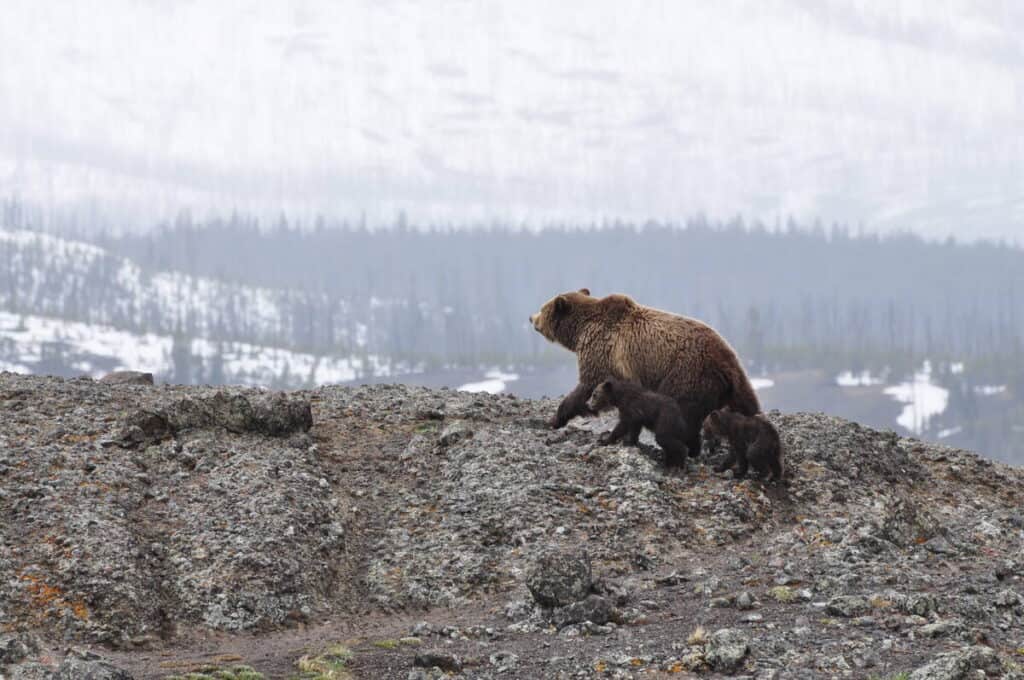
Famous and Notorious Bears in Banff
Several bears gained notoriety throughout the park due to their aggressive behavior, endangering tourists. Here’s a list of the most notorious ones:
Bear 122, aka “The Boss”. This grizzly owes his nickname due to his size and distinctive ears. He weighs between 295-315 kg (650 and 697 pounds).
He once devoured a black bear. It is claimed that he has even shrugged off getting hit by a train.
The Boss is likely the most dominant grizzly bear in Banff National Park. His estimated home range is larger than 2,500 square kilometers.
However, he shares part of his territory with another big male grizzly, number 136, aka “Split Lip”, because he has a scar on his mouth. A Canmore photographer caught them fighting in August 2020. The two grizzlies are known to be the most dominant grizzly bears in the park.
Split Lip is notorious for having killed another grizzly in the Mystic Pass area of the park and a cub. To make it even scarier: Split Lip is known for his bold attitude to people. According to Jon Stuart-Smith from Parks Canada, he doesn’t shy away.
Not as ferocious, as far we know, but also well-known is a white grizzly bear called “Nakoda”. He’s been spotted in Banff and Yoho National Parks since 2017. His striking coat is a very rare occurrence.
While bears in Banff National Park are wild creatures that roam freely, two bears previously lived in the town of Banff at different moments in the town’s history.
To draw guests’ attention, Banff businessman Norman Luxton kept a black bear cub named “Teddy” outside the Trading Post on 101 Cave Avenue. Tourists and locals primarily fed him chocolate and biscuits.
A polar bear also previously lived in Banff. At the time, the area that is now Central Park housed a modest zoo. When it was opened in 1907, it had lynxes, monkeys, cougars, and, at one point, polar bear “Buddy“. Due to both animal cruelty reasons and dire economic circumstances, the zoo was forced to close in 1937.
Selected Sources
- Human injuries inflicted by bears in Alberta: 1960–98 Herrero, Stephen, and Higgins, Andrew. Environmental Science, Faculty of Environmental Design, University of Calgary, 1998.
- Garshelis, Dave & GIBEAU, MICHAEL & Herrero, Stephen. (2009). Grizzly bear demographics in and around Banff National Park and Kananaskis Country, Alberta. Journal of Wildlife Management. 69. 277-297. 10.2193/0022-541X(2005)069<0277:GBDIAA>2.0.CO;2.
- parks.canada.ca

